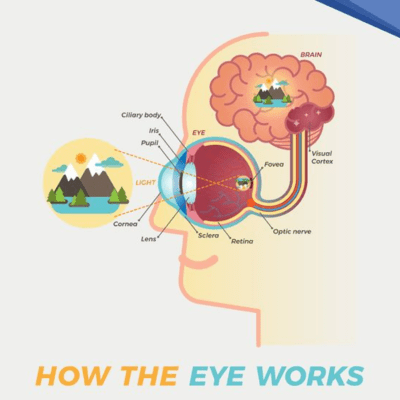Our eyes, often described as the gateways to our inner world, are instrumental in shaping our daily encounters. However, the intricacies of visual perception transcend mere physical structures like lenses and corneas. They delve into the profound workings of our brain, where intricate neural pathways decipher and make sense of the visual stimuli captured by our eyes. In this journey of discovery, we embark on an exploration of the captivating link between the eye and the brain, unraveling the marvels of visual cognition.

- The Marvel of Vision:
Vision, a cornerstone of human perception, begins with the eyes capturing light and transforming it into electrical signals. The cornea and lens work together to focus light onto the retina, a layer of light-sensitive cells at the back of the eye. These cells, called photoreceptors, initiate the conversion of light into electrical impulses that set the stage for the journey into the brain.
- From Retina to Optic Nerve:
As the electrical signals spark in the retina, they travel along the optic nerve a highway of information transmission connecting the eye to the brain. This crucial pathway ensures the swift delivery of visual data to the brain’s command center, the visual cortex.
- The Visual Cortex:
Nestled at the back of the brain, the visual cortex is a mosaic of neural regions dedicated to different aspects of visual processing. Here, the raw visual data undergoes intricate transformations. Edge detection, color analysis, and motion perception are just a few of the complex tasks performed by the visual cortex to construct the images we perceive.
- Perception vs. Reality:
Interestingly, what we perceive is not always a faithful representation of reality. The brain, with its ability to fill in gaps and make assumptions, often crafts a version of the visual world that aligns with our expectations. This phenomenon, known as perceptual constancy, allows us to recognize objects regardless of changes in their appearance due to lighting or perspective.
- Beyond Sight: Multisensory Integration:
The eye-brain connection doesn’t operate in isolation. It collaborates with other sensory systems, such as hearing and touch, to create a holistic perception of the environment. The brain seamlessly integrates information from various senses, contributing to our ability to navigate and comprehend the world.
- The Intricacies of Visual Processing Disorders:
In some instances, disruptions in the eye-brain connection can lead to visual processing disorders. Conditions like dyslexia and visual agnosia shed light on the delicate balance required for smooth visual perception. Understanding these disorders unravels the complexity of the brain’s role in shaping our visual experiences.
The eye-brain connection is a testament to the remarkable synergy between our sensory organs and the intricate neural networks within our brain. As we continue to unveil the mysteries of visual perception, we gain deeper insights into the marvels of human cognition. From the reception of light on the retina to the kaleidoscopic realms of the visual cortex, our journey through the eye-brain connection is a captivating exploration of the essence of sight.
